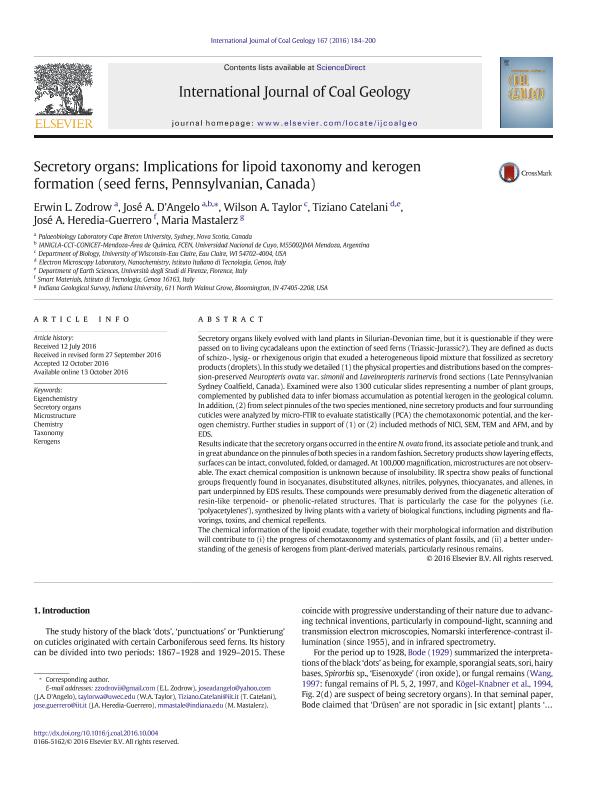Mostrar el registro sencillo del ítem
dc.contributor.author
Zodrow, Erwin L.
dc.contributor.author
D`angelo, José Alejandro

dc.contributor.author
Taylor, Wilson A.
dc.contributor.author
Catelani, Tiziano
dc.contributor.author
Heredia-Guerrero, José A.
dc.contributor.author
Mastalerz, Maria
dc.date.available
2022-12-28T11:12:30Z
dc.date.issued
2016-10
dc.identifier.citation
Zodrow, Erwin L.; D`angelo, José Alejandro; Taylor, Wilson A.; Catelani, Tiziano; Heredia-Guerrero, José A.; et al.; Secretory organs: Implications for lipoid taxonomy and kerogen formation (Seed ferns, Pennsylvanian, Canada); Elsevier Science; International Journal Of Coal Geology; 167; 10-2016; 184-200
dc.identifier.issn
0166-5162
dc.identifier.uri
http://hdl.handle.net/11336/182628
dc.description.abstract
Secretory organs likely evolved with land plants in Silurian-Devonian time, but it is questionable if they were passed on to living cycadaleans upon the extinction of seed ferns (Triassic-Jurassic?). They are defined as ducts of schizo-, lysig- or rhexigenous origin that exuded a heterogeneous lipoid mixture that fossilized as secretory products (droplets). In this study we detailed (1) the physical properties and distributions based on the compression-preserved Neuropteris ovata var. simonii and Laveineopteris rarinervis frond sections (Late Pennsylvanian Sydney Coalfield, Canada). Examined were also 1300 cuticular slides representing a number of plant groups, complemented by published data to infer biomass accumulation as potential kerogen in the geological column. In addition, (2) from select pinnules of the two species mentioned, nine secretory products and four surrounding cuticles were analyzed by micro-FTIR to evaluate statistically (PCA) the chemotaxonomic potential, and the kerogen chemistry. Further studies in support of (1) or (2) included methods of NICI, SEM, TEM and AFM, and by EDS. Results indicate that the secretory organs occurred in the entire N. ovata frond, its associate petiole and trunk, and in great abundance on the pinnules of both species in a random fashion. Secretory products show layering effects, surfaces can be intact, convoluted, folded, or damaged. At 100,000 magnification, microstructures are not observable. The exact chemical composition is unknown because of insolubility. IR spectra show peaks of functional groups frequently found in isocyanates, disubstituted alkynes, nitriles, polyynes, thiocyanates, and allenes, in part underpinned by EDS results. These compounds were presumably derived from the diagenetic alteration of resin-like terpenoid- or phenolic-related structures. That is particularly the case for the polyynes (i.e. ‘polyacetylenes’), synthesized by living plants with a variety of biological functions, including pigments and flavorings, toxins, and chemical repellents. The chemical information of the lipoid exudate, together with their morphological information and distribution will contribute to (i) the progress of chemotaxonomy and systematics of plant fossils, and (ii) a better understanding of the genesis of kerogens from plant-derived materials, particularly resinous remains.
dc.format
application/pdf
dc.language.iso
eng
dc.publisher
Elsevier Science

dc.rights
info:eu-repo/semantics/openAccess
dc.rights.uri
https://creativecommons.org/licenses/by-nc-sa/2.5/ar/
dc.subject
CHEMISTRY
dc.subject
EIGENCHEMISTRY
dc.subject
KEROGENS
dc.subject
MICROSTRUCTURE
dc.subject
SECRETORY ORGANS
dc.subject
TAXONOMY
dc.subject.classification
Paleontología

dc.subject.classification
Ciencias de la Tierra y relacionadas con el Medio Ambiente

dc.subject.classification
CIENCIAS NATURALES Y EXACTAS

dc.title
Secretory organs: Implications for lipoid taxonomy and kerogen formation (Seed ferns, Pennsylvanian, Canada)
dc.type
info:eu-repo/semantics/article
dc.type
info:ar-repo/semantics/artículo
dc.type
info:eu-repo/semantics/publishedVersion
dc.date.updated
2022-12-27T18:16:35Z
dc.journal.volume
167
dc.journal.pagination
184-200
dc.journal.pais
Países Bajos

dc.journal.ciudad
Amsterdam
dc.description.fil
Fil: Zodrow, Erwin L.. University of Cape Town; Sudáfrica
dc.description.fil
Fil: D`angelo, José Alejandro. Consejo Nacional de Investigaciones Científicas y Técnicas. Centro Científico Tecnológico Conicet - Mendoza. Instituto Argentino de Nivología, Glaciología y Ciencias Ambientales. Provincia de Mendoza. Instituto Argentino de Nivología, Glaciología y Ciencias Ambientales. Universidad Nacional de Cuyo. Instituto Argentino de Nivología, Glaciología y Ciencias Ambientales; Argentina
dc.description.fil
Fil: Taylor, Wilson A.. University of Wisconsin; Estados Unidos
dc.description.fil
Fil: Catelani, Tiziano. Università degli Studi di Firenze; Italia
dc.description.fil
Fil: Heredia-Guerrero, José A.. No especifíca;
dc.description.fil
Fil: Mastalerz, Maria. Indiana University; Estados Unidos
dc.journal.title
International Journal Of Coal Geology

dc.relation.alternativeid
info:eu-repo/semantics/altIdentifier/url/https://www.sciencedirect.com/science/article/abs/pii/S016651621630369X
dc.relation.alternativeid
info:eu-repo/semantics/altIdentifier/doi/http://dx.doi.org/10.1016/j.coal.2016.10.004
Archivos asociados
